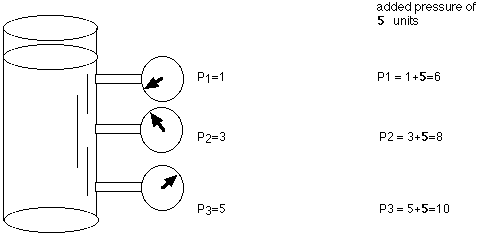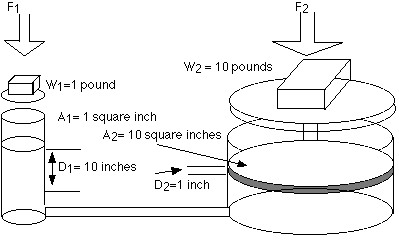Pascal's Principle and Hydraulics
SUBJECT: Physics
TOPIC: Hydraulics
DESCRIPTION: A set of mathematics problems dealing with hydraulics.
CONTRIBUTED BY: Carol Hodanbosi
EDITED BY: Jonathan G. Fairman - August 1996
Hydraulic systems use a incompressible fluid, such as oil or
water, to transmit forces from one location to another within the
fluid. Most aircraft use hydraulics in the braking systems and
landing gear. Pneumatic systems use compressible fluid, such as air,
in their operation. Some aircraft utilize pneumatic systems for their
brakes, landing gear and movement of flaps.
Pascal's law states that when there is an increase in pressure
at any point in a confined fluid, there is an equal increase at
every other point in the container.
A container, as shown below, contains a fluid. There is an
increase in pressure as the length of the column of liquid increases,
due to the increased mass of the fluid above.
For example, in the figure below, P3 would be the highest value of
the three pressure readings, because it has the highest level of
fluid above it.

If the above container had an increase in overall pressure, that
same added pressure would affect each of the gauges (and the liquid
throughout) the same. For example P1, P2, P3 were originally 1, 3, 5
units of pressure, and 5 units of pressure were added to the system,
the new readings would be 6, 8, and 10.
Applied to a more complex system below, such as a hydraulic car
lift, Pascal's law allows forces to be multiplied. The cylinder on
the left shows a cross-section area of 1 square inch, while the
cylinder on the right shows a cross-section area of 10 square inches.
The cylinder on the left has a weight (force) on 1 pound acting
downward on the piston, which lowers the fluid 10 inches. As a result
of this force, the piston on the right lifts a 10 pound weight a
distance of 1 inch.
The 1 pound load on the 1 square inch area causes an increase in
pressure on the fluid in the system. This pressure is distributed
equally throughout and acts on every square inch of the 10 square
inch area of the large piston. As a result, the larger piston lifts
up a 10 pound weight. The larger the cross-section area of the second
piston, the larger the mechanical advantage, and the more weight it
lifts.

The formulas that relate to this are shown below:
P1 = P2 (since the pressures are equal
throughout).
Since pressure equals force per unit area, then it follows
that
F1/A1 = F2/A2
It can be shown by substitution that the values shown above are
correct,
1 pound / 1 square inches = 10 pounds /
10 square inches
Because the volume of fluid pushed down on the left side equals
the volume of fluid that is lifted up on the right side, the
following formula is also true.
V1 = V2
by substitution,
A1 D1 = A2 D2
- A = cross sectional area
- D = the distance moved
or
A1/A2= D2/D1
This system can be thought of as a simple machine (lever), since
force is multiplied.The mechanical advantage can be found by
rearranging terms in the above equation to
Mechanical Advantage(IMA) = D1/D2 = A2/A1
For the sample problem above, the IMA would be 10:1 (10 inches/ 1
inch or 10 square inches / 1 square inch).
Given these simple formulas, try to answer the questions
below.
Exercises:
- A hydraulic press has an input cylinder 1 inch in diameter and
an output cylinder 6 inches in diameter.
- Assuming 100% efficiency, find the force exerted
by the output piston when a force of 10 pounds is applied to
the input piston.
(answer)
- If the input piston is moved through 4 inches, how far is
the output piston moved?
(answer)
- A hydraulic system is said to have a mechanical advantage of
40. Mechanical advantage (MA) is FR (output) / FE (input). If the
input piston, with a 12 inch radius, has a force of 65 pounds
pushing downward a distance of 20 inches, find
- the volume of fluid that has been displaced
(answer)
- the upward force on the output piston
(answer)
- the radius of the output piston
(answer)
- the distance the output piston moves
(answer)
- What pressure does a 130 pound woman exert on the floor when
she balances on one of her heels? Her heels have an average radius
of 0.5 inch.
(answer)
- A car has a weight of 2500 pounds and rests on four tires,
each having a surface area of contact with the ground of 14 square
inches. What is the pressure the ground experiences beneath the
tires that is due to the car?
(answer)
Extension :
- The input and output pistons of a hydraulic jack are
respectively 1 cm and 4 cm in diameter. A lever with a mechanical
advantage of 6 is used to apply force to the input piston. How
much mass can the jack lift if a force of 180 N is applied to the
lever and efficiency is 80%?
(answer)
Related Pages:
Aeronautics Activities
Aerospace Activities Page
Aerodynamics Index
Air Pressure
|
